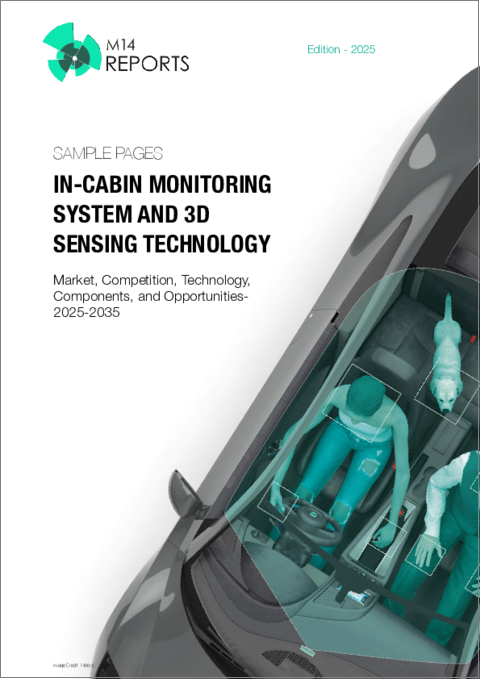|
|
市場調査レポート
商品コード
1669756
車内モニタリングシステム(ICMS)の世界市場:技術、市場、機会、競合(2025年~2035年)Global In-cabin Monitoring System (ICMS): Technology, Market, Opportunities, Competition, 2025-2035 |
||||||
|
|||||||
| 車内モニタリングシステム(ICMS)の世界市場:技術、市場、機会、競合(2025年~2035年) |
|
出版日: 2025年03月05日
発行: M14 Intelligence
ページ情報: 英文 80+ Pages
納期: 即日から翌営業日
|
全表示
- 概要
- 目次
世界の自動車産業では、景気回復、技術の進歩、消費者の選好の進化により、2023年以降、乗用車の需要が大幅に回復しています。
乗用車需要の増加
パンデミック後の自動車部門は力強い回復を見せ、主要市場で乗用車の売上が急増しています。欧州では、2023年の乗用車の新車売上は1,500万台に達し、前年比18.7%の伸びを記録しました。この急成長の主因は、電気自動車(EV)の普及と政府のインセンティブです。米国もこれに続き、前年比9%増の約310万台の売上を記録しました。世界最大の自動車市場である中国は、都市化と可処分所得の上昇を追い風に、2023年の乗用車の売上が2,600万台を超えました。日本とインドも、小型車と中型車の需要の増加に支えられ、それぞれ400万台と410万台の売上を記録し、成長を示しました。
この増加傾向は2024年も続き、世界の乗用車売上は5%~7%増加すると予測されます。電気自動車やハイブリッド車へのシフトと自動車技術の進歩により、産業の情勢は大きく変わりつつあります。
乗用車におけるADAS普及率の倍増
ADAS(先進運転支援システム)は、安全性と運転の利便性を向上させる現代の自動車の要となっています。乗用車におけるADASの普及率は過去2年間で大きく伸びています。2023年、米国で販売される新車の約50%がアダプティブクルーズコントロール、レーンキープアシスト、自動緊急ブレーキなどのADAS機能を搭載しています。欧州と中国では、厳しい安全規制と先進機能に対する消費者の需要に後押しされ、それぞれ55%、60%と、さらに高い普及率が報告されています。
ADASを搭載した自動車の売上は2023年以降、毎年20%~25%ずつ増加しており、これは事故の削減と交通安全の向上におけるこれらのシステムの重要性の高まりを反映しています。
事故防止に関する規制政策が車内モニタリングシステム(ICMS)の成長を促進
世界の規制政策は、自動車への車内モニタリングシステム(ICMS)の搭載を義務付けるうえで極めて重要な役割を果たしています。欧州連合(EU)の一般安全規則(GSR)は2022年から施行され、すべての新車にドライバーの眠気と注意力を警告するシステムを搭載するよう義務付けています。同様に、米国のNational Highway Traffic Safety Administration(NHTSA)は、脇見運転や疲労運転といったヒューマンエラーによる事故を防止するため、ドライバーモニタリングシステムを自動車に搭載する規制を提案しています。
このような政策により、自動車メーカーはDMSやOMSを車両に組み込むことを推進し、コンプライアンスを確保し、安全基準を強化しています。ヒューマンエラーによる事故の防止への注目により、車内モニタリングシステム(ICMS)は現代の自動車の重大なコンポーネントとなっています。
乗用車に統合されたDMSとOMSの採用の増加
ドライバーモニタリングシステム(DMS)と乗員モニタリングシステム(OMS)の採用は、ADAS搭載車と非搭載車の両方で着実に増加しています。2023年に、米国では新車の乗用車の約30%がDMSを搭載し、欧州では35%の普及率が報告されました。中国と日本の普及率もそれぞれ40%と25%と、大きな伸びを示しています。
全乗員の存在と行動をモニターするOMSは、特にADAS機能を備えた車両で普及が進んでいます。DMSとOMSの統合は、規制要件と包括的な車内安全ソリューションの必要性に後押しされ、標準的な慣行となりつつあります。
車内モニタリングシステム(ICMS)市場のその他の成長促進要因
- 交通安全に対する消費者の意識の高まりが、先進のモニタリングシステムへの需要を押し上げています。
- AI、コンピュータービジョン、センサー技術における技術革新がDMSとOMSの機能を強化しています。
- 自動運転車の動向の高まりが、乗客の安全を確保する強固な車内モニタリングシステム(ICMS)の必要性を喚起しています。
当レポートでは、世界の車内モニタリングシステム(ICMS)市場について調査分析し、市場規模と売上の予測、業界動向、乗用車の売上の予測、ICMSの搭載車数などの情報を提供しています。
取り上げる企業
|
|
目次
第1章 エグゼクティブサマリー
第2章 レポートの調査範囲
第3章 産業の動向と力学
- ステアリングベースのパッシブモニタリングに対するアクティブドライバーモニタリングの重要性
- 安全規制がアクティブ車内モニタリングシステム(ICMS)の需要を促進
- EUの規制
- 中国の規制
- 日本の規制
- 北米の規制
- アクティブ車内モニタリングに向けた業界のステークホルダーの取り組み
- 主要OEMのアクティブDMS、乗員モニタリングシステム(OMS)- 誰が何を行っているか
- パートナーシップマッピング - OEM、Tier 1、DMS/OMSソリューションサプライヤー
- エコシステムを理解する - 主なTier 1、ソフトウェアソリューション、ソフトウェア+ハードウェア企業
第4章 世界の乗用車の売上の予測 - 自動化レベル別、地域別の内訳
第5章 シェアードモビリティ自動運転車の売上の予測 - 地域別の内訳
第6章 車内モニタリング - 市場浸透と搭載車数(2019年~2030年)
- レベル2/レベル2+の車両
- レベル3/レベル4 - ハイウェイパイロット車両
- シェアードモビリティ都市自動運転車 - ロボタクシー、シャトル
第7章 需要を理解する - 地理的分析
- 米国・カナダ
- 中国・日本・韓国
- 西欧・ロシア
- その他
第8章 車内モニタリングの市場規模と売上需要の予測、用途別の内訳(2025年~2035年)
- 安全用途 - DMS、OMS、幼児置き去り検知
- ユーザーエクスペリエンス/HMI用途
第9章 車内モニタリングの市場規模、売上需要、ASPの予測、技術タイプ別の内訳(2025年~2035年)
- 3Dセンシング(ToF、VCSEL)
- 高解像度カメラ
- 赤外線センシング(IR、NIR)
- レーダーベースシステム
- 4Dレーダーオンチップ
- 2D/3Dレーダー
第10章 車内モニタリングシステム(ICMS)の市場規模とASPの予測、ハードウェア別、ソフトウェア別の内訳(2019年~2030年)
- ハードウェア(ECU、ToF、レーダー、RGB、IR)
- AIソフトウェア
第11章 ソフトウェア vs. ハードウェア車内システム - 将来の市場動向
- AI主導のDMS技術の動向
第12章 競合の評価
- デザインウィン
- 市場投入までの時間
- OEM・Tier-1とのパートナーシップ
- フルスタック開発者
- センサー・ハードウェアプロバイダー
- ソフトウェア・AIプロバイダー
第13章 付録
第14章 調査手法
第15章 二次情報源のリスト
第16章 M14 Intelligenceについて
The global automotive industry has witnessed a significant resurgence in demand for passenger vehicles since 2023, driven by economic recovery, technological advancements, and evolving consumer preferences. This new report Edition 2025 of In-Cabin Monitoring Systems explores the historical and future sales trends of passenger vehicles, the rapid penetration of Advanced Driver Assistance Systems (ADAS), and the increasing importance of in-cabin monitoring systems, such as Driver Monitoring Systems (DMS) and Occupant Monitoring Systems (OMS), in enhancing driver safety and preventing accidents.
Rising Demand for Passenger Vehicles
The post-pandemic era has seen a robust recovery in the automotive sector, with passenger vehicle sales surging across key markets. In Europe, the sales of new passenger cars climbed to 15 million units in 2023, recording year-on-year growth of 18.7%. This whooping growth was majorly driven by the adoption of electric vehicles (EVs) and government incentives. The U.S. followed the suite, reflecting a 9% year-on-year growth accounting for sales volumes of approximately 3.1 million units. China, the world's largest automotive market, recorded sales of over 26 million passenger vehicles in 2023, fueled by urbanization and rising disposable incomes. Japan and India also experienced growth, with sales volumes of 4 million and 4.1 million units, respectively, supported by increasing demand for compact and mid-sized vehicles.
This upward trend continued in 2024, with estimates indicating a 5-7% growth in global passenger vehicle sales. The shift toward electric and hybrid vehicles, coupled with advancements in automotive technology, is reshaping the industry landscape.
Doubling Penetration Rate of ADAS in Passenger Vehicles
Advanced Driver Assistance Systems (ADAS) have become a cornerstone of modern vehicles, enhancing safety and driving convenience. The penetration rate of ADAS in passenger vehicles has grown significantly over the past two years. In 2023, approximately 50% of new vehicles sold in the U.S. were equipped with ADAS features, such as adaptive cruise control, lane-keeping assist, and automatic emergency braking. Europe and China reported even higher adoption rates, at 55% and 60%, respectively, driven by stringent safety regulations and consumer demand for advanced features.
The sales of vehicles equipped with ADAS have grown by 20-25% annually since 2023, reflecting the increasing importance of these systems in reducing accidents and improving road safety.
Regulatory Policies on Accident Prevention is Driving the Growth of In-Cabin Monitoring Systems
Regulatory policies worldwide are playing a pivotal role in mandating the inclusion of in-cabin monitoring systems in vehicles. The European Union's General Safety Regulation (GSR), effective from 2022, requires all new vehicles to be equipped with driver drowsiness and attention warning systems. Similarly, the U.S. National Highway Traffic Safety Administration (NHTSA) has proposed regulations to include driver monitoring systems in vehicles to prevent accidents caused by human error, such as distracted or fatigued driving.
These policies are driving automakers to integrate DMS and OMS into their vehicles, ensuring compliance and enhancing safety standards. The focus on preventing accidents caused by human error has made in-cabin monitoring systems a critical component of modern vehicles.
Rising Adoption of DMS and OMS Integrated Passenger Vehicles
The adoption of Driver Monitoring Systems (DMS) and Occupant Monitoring Systems (OMS) has seen a steady rise in both ADAS-equipped and non-ADAS vehicles. In 2023, approximately 30% of new passenger vehicles in the U.S. were equipped with DMS, while Europe reported a penetration rate of 35%. China and Japan also witnessed significant adoption, with rates of 40% and 25%, respectively.
OMS, which monitors the presence and behavior of all occupants, is gaining traction, particularly in vehicles with ADAS features. The integration of DMS and OMS is becoming a standard practice, driven by regulatory requirements and the need for comprehensive in-cabin safety solutions.
Other Factors Driving the Growth of the In-Cabin Monitoring System Market
- Increasing Consumer Awareness about road safety is boosting demand for advanced monitoring systems.
- Technology Innovations in AI, computer vision, and sensor technology are enhancing the capabilities of DMS and OMS
- Rising Autonomous Vehicles trend has induced the need for robust in-cabin monitoring systems to ensure passenger safety
The in-cabin monitoring system market is rapidly evolving, driven by technological advancements, regulatory mandates, and increasing consumer demand for safety. As competition intensifies, suppliers are innovating to offer more advanced and cost-effective solutions, ensuring a safer and more connected driving experience.
The future scope of these systems is vast, with advancements in artificial intelligence (AI) and machine learning enabling more sophisticated monitoring capabilities. By 2030, it is estimated that 70-80% of new vehicles globally will be equipped with DMS and OMS, driven by regulatory mandates and consumer demand for safer vehicles.
COMPANIES MENTIONED:
|
|
Table of Contents
1. Executive Summary
2. Scope of this Report
3. Industry Trends and Dynamics
- 3.1. Importance of Active Driver Monitoring over Steering-based Passive Monitoring
- 3.2. Safety Regulations Driving Active In-cabin Monitoring Systems Demand
- 3.3. Regulations in EU
- 3.4. Regulations in China
- 3.5. Regulations in Japan
- 3.6. Regulations in North America
- 3.7. Initiatives by Industry Stakeholders towards Active In-cabin Monitoring
- 3.8. Active DMS and Occupant Monitoring Systems (OMS) of Leading OEMs - Who is doing What?
- 3.9. Partnership Mapping - OEMs, Tier 1s, and DMS/OMS Solution Suppliers
- 3.10. Understanding the Ecosystem - Leading Tier 1s, Software Solution, and Software + Hardware Players
4. Global Passenger Car Sales Forecast - Breakdown by Levels of Automation and Region
5. Autonomous Shared Mobility Vehicle Sales Forecast - Breakdown by Region
6. In-cabin Monitoring - Market Penetration and Equipped Vehicles Installed Base, 2019 to 2030
- 6.1. Level 2/Level 2+ Vehicles
- 6.2. Level 3/Level 4 - Highway Pilot Vehicles
- 6.3. Autonomous Shared Mobility Urban Vehicles - Robotaxis and Shuttles
7. Understanding the Demand - Geographical Analysis
- 7.1. United States and Canada
- 7.2. China, Japan, and South Korea
- 7.3. Western Europe and Russia
- 7.4. Others
8. In-cabin Monitoring Market Size and Sales Demand Forecast, Breakdown by Applications, 2025 to 2035
- 8.1. Safety Application - DMS, OMS, Left-child Detection
- 8.2. User Experience/HMI Application
9. In-cabin Monitoring Market Size, Sales Demand, and ASP Forecast, Breakdown by Technology Type, 2025 to 2035
- 9.1. 3D Sensing (ToF, VCSEL)
- 9.2. High Resolution Camera
- 9.3. Infrared Sensing (IR, NIR)
- 9.4. Radar based System
- 9.4.1. 4D Radar-on-chip
- 9.4.2. 2D/3D Radar
10. In-cabin Monitoring System Market Size and ASP Forecast, Breakdown by Hardware and Software, 2019 to 2030
- 10.1. Hardware (ECU, ToF, Radar, RGB and IR)
- 10.2. AI Software
11. Software vs Hardware In-cabin System - Future Market Trends
- 11.1. AI driven DMS Technology Trends
12. Competition Assessment
- 12.1. Design wins
- 12.2. Time-to-Market
- 12.3. Partnerships with OEMs and Tier-1s
- 12.3.1. Full Stack Developers
- 12.3.1.1. Aptiv
- 12.3.1.2. Bosch
- 12.3.1.3. Continental
- 12.3.1.4. Gentex Corporation
- 12.3.1.5. Valeo
- 12.3.1.6. Magna
- 12.3.1.7. BHTC
- 12.3.2. Sensors and Hardware Providers
- 12.3.2.1. Infineon
- 12.3.2.2. iEE
- 12.3.2.3. Sony
- 12.3.2.4. STMicroelectronics
- 12.3.2.5. Omnivision
- 12.3.2.6. Eye4NIR
- 12.3.2.7. Novelic
- 12.3.2.8. Smartmicro
- 12.3.2.9. Viavi
- 12.3.2.10. Qualcomm
- 12.3.2.11. Lumentum
- 12.3.2.12. LG
- 12.3.2.13. Harman
- 12.3.2.14. Panasonic
- 12.3.2.15. Garmin
- 12.3.2.16. Melexis
- 12.3.3. Software and AI provider
- 12.3.3.1. Seeing Machine
- 12.3.3.2. SmartEye
- 12.3.3.3. Eyeris
- 12.3.3.4. Tobii
- 12.3.3.5. Veoneer
- 12.3.3.6. Multicore
- 12.3.3.7. Cipia
- 12.3.1. Full Stack Developers






